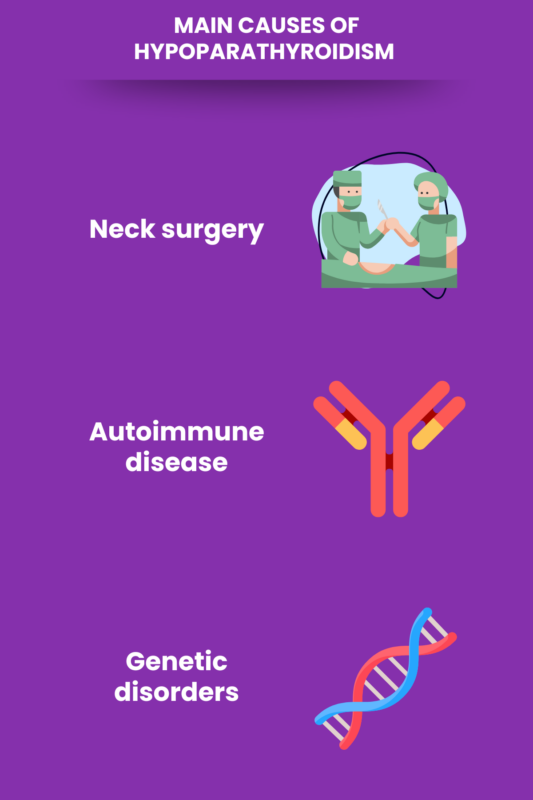
Hypoparathyroidism causes
Last updated June 10, 2025, by Marisa Wexler, MS

Hypoparathyroidism is most commonly caused by surgery, autoimmune reactions, or genetic mutations, although the condition may also result from radiation therapy, iron overload, or imbalances in minerals such as magnesium.
There are several hypoparathyroidism types, each defined by its specific underlying cause and requiring different approaches to disease management. However, all are marked by abnormally low levels of parathyroid hormone (PTH), a signaling molecule that helps regulate calcium and phosphorus in the body.
This occurs because there’s damage or a problem with the development or function of the parathyroid glands — small glands located in the neck near the thyroid gland — which results in reduced production of PTH. This, in turn, causes a reduction in calcium levels, leading to hypoparathyroidism symptoms such as muscle spasms, mental health changes, and kidney damage.
A hypoparathyroidism diagnosis typically involves testing for low blood levels of PTH and calcium. However, additional tests are often needed to identify the exact causes of hypoparathyroidism and determine a person’s specific disease type, which is important to guide disease management and ensure the best possible outcomes for patients.
Main causes of hypoparathyroidism
All forms of hypoparathyroidism are marked by abnormally low PTH levels, but the underlying reasons for why the parathyroid glands might be damaged or not working as normal vary, depending on the disease type.
Understanding the causes of hypoparathyroidism is critical for guiding treatment decisions and improving outcomes, including quality of life and life expectancy.
Acquired hypoparathyroidism
Acquired hypoparathyroidism refers to cases of hypoparathyroidism that develop after birth, during a person’s lifetime, due to damage to the parathyroid glands.
In the vast majority of cases, acquired hypoparathyroidism develops as a complication of neck surgery — for example, when surgery is done to remove part or all of the thyroid, the nearby parathyroid glands can be accidentally damaged. This form of the disease, sometimes called postsurgical hypoparathyroidism, accounts for about three-quarters of all cases.
By some estimates, more than 1 in 3 neck surgeries will cause hypoparathyroidism. And while most people recover parathyroid function within a few months after surgery, a small percentage (about 5% or fewer), develop chronic hypoparathyroidism that lasts more than six months.
There are also other rarer causes of acquired hypoparathyroidism, which may include:
- iron overload, which can result from conditions such as hemochromatosis
- excess copper accumulation, as seen in Wilson disease
- magnesium imbalance, especially low magnesium levels, which can impair parathyroid function
- radiation therapy to the neck, which may damage the parathyroid glands
- cancers that spread to the parathyroid glands.
Autoimmune hypoparathyroidism
Autoimmune hypoparathyroidism is an inflammatory disease that occurs when the immune system accidentally attacks the parathyroid glands. It is the second most common form of the disease, after postsurgical hypoparathyroidism.
Autoimmune hypoparathyroidism may occur isolated or as part of a broader condition known as autoimmune polyglandular syndrome, wherein the immune system mistakenly targets the parathyroid glands as well as other tissues and organs.
While the exact causes of autoimmune hypoparathyroidism aren’t fully understood, patients often have antibodies that target proteins in the parathyroid glands, which may damage or interfere with the function of these glands.
Congenital hypoparathyroidism
Congenital hypoparathyroidism is a form of the disease that is present from birth. It arises due to issues with the development of the parathyroid glands, or certain genetic disorders that also affect other parts of the body.
Inherited conditions that cause congenital hypoparathyroidism may include:
- polyglandular autoimmune syndrome type 1, which is caused by mutations in the AIRE gene
- DiGeorge syndrome, which is caused by mutations in the TBX1 gene
- hypoparathyroidism-retardation-dysmorphism syndrome, or Sanjad–Sakati syndrome, which is caused by mutations in the TBCE gene
- hypoparathyroidism-deafness-renal dysplasia syndrome, also called Barakat syndrome, which is caused by mutations in the GATA3 gene
- Kenny-Caffey syndrome, which is caused by mutations in the FAM111A gene
- Kearns-Sayre syndrome, mitochondrial encephalopathy, and mitochondrial trifunctional protein deficiency syndrome, which are disorders caused by mutations in genes implicated in the function of mitochondria, the cellular structures used for energy production.
Familial isolated hypoparathyroidism
Familial isolated hypoparathyroidism (FIH) is a group of genetic disorders characterized by hypoparathyroidism that occurs without other associated health conditions. These cases are usually caused by mutations in genes involved in PTH production and secretion.
For most genes, everyone inherits two copies, one from each biological parent. Some forms of FIH are autosomal dominant, meaning that inheriting one mutated gene is sufficient to develop the disease. Genes associated with autosomal dominant FIH include:
- PTH
- GCM2
- GNA11
- CASR
Other types of FIH are autosomal recessive, meaning the disease will only develop if a person inherits two mutated copies of the gene. Genes associated with autosomal recessive FIH include:
- PTH
- GCM2
There are also forms of FIH caused by mutations in the SOX3 gene. These are inherited in an X-linked manner because the affected gene is on the sex-determining X chromosome.
Because biological females have two X chromosomes and biological males only have one, X-linked diseases generally affect males. Females have a second copy of the gene that can usually compensate for the mutated version.
Idiopathic hypoparathyroidism
Idiopathic hypoparathyroidism refers to cases where the underlying cause of hypoparathyroidism is not known. People may have yet-undiscovered genetic or autoimmune disorders but, by definition, the cause of their idiopathic hypoparathyroidism is not clear.
Pseudohypoparathyroidism
Pseudohypoparathyroidism is a rare genetic disorder where the parathyroid glands produce normal or elevated amounts of PTH, but the body cannot respond to the hormone effectively. As PTH signaling is impaired, calcium levels in the blood drop and phosphorus levels rise, leading to symptoms that are generally similar to those in hypoparathyroidism.

Risk factors
Some people may have a higher risk of developing hypoparathyroidism based on their medical history or genetics. Risk factors for hypoparathyroidism include:
- a recent history of neck surgery, especially thyroid surgery
- a family history of parathyroid disorders
- having certain autoimmune diseases, such as Addison’s disease.
Hypoparathyroidism News is strictly a news and information website about the disease. It does not provide medical advice, diagnosis, or treatment. This content is not intended to be a substitute for professional medical advice, diagnosis, or treatment. Always seek the advice of your physician or other qualified health provider with any questions you may have regarding a medical condition. Never disregard professional medical advice or delay in seeking it because of something you have read on this website.
Recent Posts
- New 5-tier system aims to better guide hypoparathyroidism treatment
- Reflections on gratitude and hope for the new year
- Rethinking my holiday plans with hypopara limitations in mind
- Hypopara’s unpredictability causes surprises during treatment
- Online tool predicts who’s at risk for chronic complication after surgery


